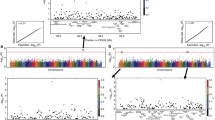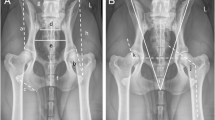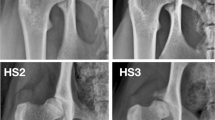Abstract
Canine hip dysplasia is a common developmental inherited trait characterized by hip laxity, subluxation or incongruity of the femoral head and acetabulum in affected hips. The inheritance pattern is complex and the mutations contributing to trait expression are unknown. In the study reported here, 240 microsatellite markers distributed in 38 autosomes and the X chromosome were genotyped on 152 dogs from three generations of a crossbred pedigree based on trait-free Greyhound and dysplastic Labrador Retriever founders. Interval mapping was undertaken to map the QTL underlying the quantitative dysplastic traits of maximum passive hip laxity (the distraction index), the dorsolateral subluxation score, and the Norberg angle. Permutation testing was used to derive the chromosome-wide level of significance at p < 0.05 for each QTL. Chromosomes 4, 9, 10, 11 (p < 0.01), 16, 20, 22, 25, 29 (p < 0.01), 30, 35, and 37 harbor putative QTL for one or more traits. Successful detection of QTL was due to the crossbreed pedigree, multiple-trait measurements, control of environmental background, and marked advancement in canine mapping tools.



Similar content being viewed by others
References
Baronciani D, Atti G, Andiloro F, Bartesaghi A, Gagliardi L, et al. (1997) Screening for developmental dysplasia of the hip: from theory to practice. Collaborative Group DDH Project. Pediatrics 99(2): E5
Beighton P, Cilliers HJ, Ramesar R (1994) Autosomal dominant (Beukes) premature degenerative osteoarthropathy of the hip joint unlinked to COL2A1. Am J Med Genet 53(4): 348–351
Bliss S, Todhunter RJ, Quaas R, Casella G, Wu R, et al.(2002) Quantitative genetics of traits associated with hip dysplasia in a canine pedigree constructed by mating dysplastic Labrador Retrievers with unaffected Greyhounds. Am J Vet Res 63(7): 1029–1035
Botstein D, White R, Skolnick M, Davis RW (1980) Construction of a genetic linkage map using restriction fragment length polymorphisms. Am J Hum Genet 32: 314–331
Breen M, Jouquand S, Renier C, Mellersh CS, Hitte C, et al. (2001) Chromosome-specific single-locus FISH probes allow anchorage of an 1800-marker integrated radiation-hybrid/linkage map of the domestic dog genome to all chromosomes. Genome Res 11(10): 1784–1795
Breen M, Hitte C, Lorentzen TD, Thomas R, Cadieu E, et al. (2004) An integrated 4249 marker FISH/RH map of the canine genome. BMC Genomics 5(1): 65
Chase K, Carrier DR, Adler FR, Jarvik T, Ostrander EA, et al. (2002) Genetic basis for systems of skeletal quantitative traits: principal component analysis of the canid skeleton. Proc Natl Acad Sci U S A 99(15): 9930–9935
Chase K, Lawler DF, Adler FR, Ostrander EA, Lark KG (2004) Bilaterally asymmetric effects of quantitative trait loci (QTLs): QTLs that affect laxity in the right versus left coxofemoral (hip) joints of the dog (Canis familiaris). Am J Med Genet 124A(3): 239–247
Churchill G (2000) Mathematical approaches to analysis of complex phenotypes. Short Course, Jackson Laboratory, Bar Harbor, ME, October 11–16, 2000
Farese JP, Todhunter RJ, Lust G, Williams AJ, Dykes NL (1998) Dorsolateral subluxation of hip joints in dogs measured in a weight-bearing position with radiography and computed tomography. Vet Surg 27(5): 393–405
Farese JP, Lust G, Williams AJ, Dykes NL, Todhunter RJ (1999) Comparison of measurements of dorsolateral subluxation of the femoral head and maximal passive laxity for evaluation of the coxofemoral joint in dogs. Am J Vet Res 60(12): 1571–1576
Glazier AM, Nadeau JH, Aitman TJ (2002) Finding genes that underlie complex traits. Science 298(5602): 2345–2349
Gratacos M, Nadal M, Hitte C, Kim L, Cadieu E, et al. (2001) A polymorphic genomic duplication on human chromosome 15 is a susceptibility factor for panic and phobic disorders. Cell 106(3): 367–379
Guyon R, Lorentzen TD, Hitte C, Kim L, Cadieu E, et al. (2003) A 1-Mb resolution radiation hybrid map of the canine genome. Proc Natl Acad Sci U S A 100(9): 5296–5301
Haley CS, Knott SA (1992) A simple regression method for mapping quantitative trait loci in line crosses using flanking markers. Heredity 69: 315–324
Henry GA (1992) Radiographic development of canine hip dysplasia. Vet Clin North Am Small Anim Pract 22(3): 559–578
Holderbaum D, Haqqi TM, Moskowitz RW (1999) Genetics and osteoarthritis: exposing the iceberg. Arthritis Rheum 42(3): 397–405
James JIP, Wynne-Davies R (1969) Factors in orthopedics. In Recent Advances in Orthopedics. Apley AG (ed.) (London: J & A Churchill Ltd) pp 1–35
Kaneene JB, Mostosky UV, Padgett GA (1997) Retrospective cohort study of changes in hip joint phenotype of dogs in the United States. J Am Vet Med Assoc 211(12): 1542–1544
Lawson DD (1963) The radiographic diagnosis of hip dysplasia in the dog. Vet Rec 75: 445–456
Leighton EA, Holle D, Roberts D (2001) The Seeing Eye breeding program: Results obtained and lessons learned. International Working Dog Breeding Conference, San Antonio, TX, 10–12 September, 2001
Lou X-Y, Todhunter RJ, Lin M, Lu Q, Liu T, et al. (2003) The extent and distribution of linkage disequilibrium in a multi-hierarchic outbred canine pedigree. Mamm Genome 14(8): 555–564
Lou X-Y, Casella G, Todhunter RJ, Yang MC, Wu R (2005) A general statistical framework for unifying interval and linkage disequilibrium mapping: toward high resolution mapping of quantitative traits. J Am Stat Assoc 100, 158–171
Lust G, Williams AJ, Burton-Wurster N, Pijanowski GJ, Beck KA, et al. (1993) Joint laxity and its association with hip dysplasia in Labrador retrievers. Am J Vet Res 54(12): 1990–1999
Lust G, Todhunter RJ, Erb HN, Dykes NL, Williams AJ, et al. (2001a) Comparison of three radiographic methods for diagnosis of hip dysplasia in eight-month-old dogs. J Am Vet Med Assoc 219(9): 1242–1246
Lust G, Todhunter RJ, Erb HN, Dykes NL, Williams AJ, et al. (2001b) Repeatability of dorsolateral subluxation scores in dogs and correlation with macroscopic appearance of hip osteoarthritis. Am J Vet Res 62(11): 1711–1715
Matise TC, Perlin M, Chakravarti A (1993) MultiMap: an expert system for automated genetic linkage mapping. Proc Int Conf Intell Syst Mol Biol 1: 260–265
Olsson SE (1961) Roentgen examination of the hip joints of German Shepherd Dogs. Adv Small Anim Pract 3: 117–118
Rendano VT, Ryan G (1985) Canine hip dysplasia evaluation. Vet Radiol 26: 170–186
Richman M, Mellersh CS, Andre C, Galibert F, Ostrander EA, et al. (2001) Characterization of a minimal screening set of 172 microsatellite markers for genome-wide screens of the canine genome. J Biochem Biophys Methods 47(1-2): 137–149
Roby P, Eyre S, Worthington J, Ramesar R, Cilliers H, et al. (1999) Autosomal dominant (Beukes) premature degenerative osteoarthropathy of the hip joint maps to an 11-cM region on chromosome 4q35. Am J Hum Genet 64(3): 904–908
SAS Institute (1988) The Princomp Procedure. In: SAS/STAT User’s Guide, v6.03. (Cary, NC: SAS Institute Inc), pp 751–772
Seaton G, Haley CS, Knott SA, Kearsey M, Visscher PM (2002) QTL Express: mapping quantitative trait loci in simple and complex pedigrees. Bioinformatics 18(2): 339–340
Smith GK (1997) Advances in diagnosing canine hip dysplasia. J Am Vet Med Assoc 210: 1451–1457
Smith GK, Gregor TP, Rhodes WH, Biery DN (1993) Coxofemoral joint laxity from distraction radiography and its contemporaneous and prospective correlation with laxity, subjective score, and evidence of degenerative joint disease from conventional hip-extended radiography in dogs. Am J Vet Res 54(7): 1021–1042
Smith GK, Popovitch CA, Gregor TP, Shofer FS (1995) Evaluation of risk factors for degenerative joint disease associated with hip dysplasia in dogs. J Am Vet Med Assoc 206(5): 642–647
Smith GK, Mayhew PD, Kapatkin AS, McKelvie PJ, Shofer FS, et al. (2001) Evaluation of risk factors for degenerative joint disease associated with hip dysplasia in German Shepherd Dogs, Golden Retrievers, Labrador Retrievers, and Rottweilers. J Am Vet Med Assoc 219(12): 1719–1724
Sollazzo V, Bertolani G, Calzolari E, Atti G, Scapoli C (2000) A two-locus model for non-syndromic congenital dysplasia of the hip (CDH). Ann Hum Genet 64(Pt 1): 51–59
Todhunter RJ, Lust G (2003) Canine hip dysplasia: pathogenesis. In Textbook of Small Animal Surgery Slatter D (ed.) (Philadelphia: W.B. Saunders) pp 2009–2019
Todhunter RJ, Zachos TA, Gilbert RO, Erb HN, Williams AJ, et al. (1997) Onset of epiphyseal mineralization and growth plate closure in radiographically normal and dysplastic Labrador retrievers. J Am Vet Med Assoc 210(10): 1458–1462
Todhunter RJ, Acland GM, Olivier M, Williams AJ, Vernier-Singer M, et al. (1999) An outcrossed canine pedigree for linkage analysis of hip dysplasia. J Hered 90(1): 83–92
Todhunter RJ, Bliss SP, Casella G, Wu R, Lust G, et al.(2003a) Genetic structure of susceptibility traits for hip dysplasia and microsatellite informativeness of an outcrossed canine pedigree. J Hered 94(1): 39–48
Todhunter RJ, Casella G, Bliss SP, Lust G, Williams AJ, et al. (2003b) Power of a Labrador Retriever-Greyhound pedigree for linkage analysis of hip dysplasia and osteoarthritis. Am J Vet Res 64(4): 418–424
Todhunter RJ, Grohn YT, Bliss SP, Wilfand A, Williams AJ, et al. (2003c) Evaluation of multiple radiographic predictors of cartilage lesions in the hip joints of eight-month-old dogs. Am J Vet Res 64(12): 1472–1478
Weber JL, Broman KW (2001) Genotyping for human whole-genome scans: past, present, and future. Adv Genet 42: 77–96
Weinstein SL (1996) Developmental hip dysplasia and dislocation. In:Morrisy RT, Weinstein SL(eds.) Lovell and Winter’s Pediatric Orthopedics Vol. II, Philadelphia: Lippincott-Raven, pp 903–950
Acknowledgments
This work was supported by the Morris Animal Foundation; Cornell Advanced Technology, Biotechnology; Consolidated Research Grant Program, the Dean’s Fund for Clinical Excellence, College of Veterinary Medicine, Cornell University; NIH grant No. R01 AR47558; Nestle-Purina Inc.; and the NHLBI Mammalian Genotyping Service, Marshfield, WI. The authors thank Jennifer Johnson for assistance with MULTIMAP.
Author information
Authors and Affiliations
Corresponding author
Rights and permissions
About this article
Cite this article
Todhunter, R.J., Mateescu, R., Lust, G. et al. Quantitative trait loci for hip dysplasia in a crossbreed canine pedigree. Mamm Genome 16, 720–730 (2005). https://doi.org/10.1007/s00335-005-0004-4
Received:
Accepted:
Published:
Issue Date:
DOI: https://doi.org/10.1007/s00335-005-0004-4




